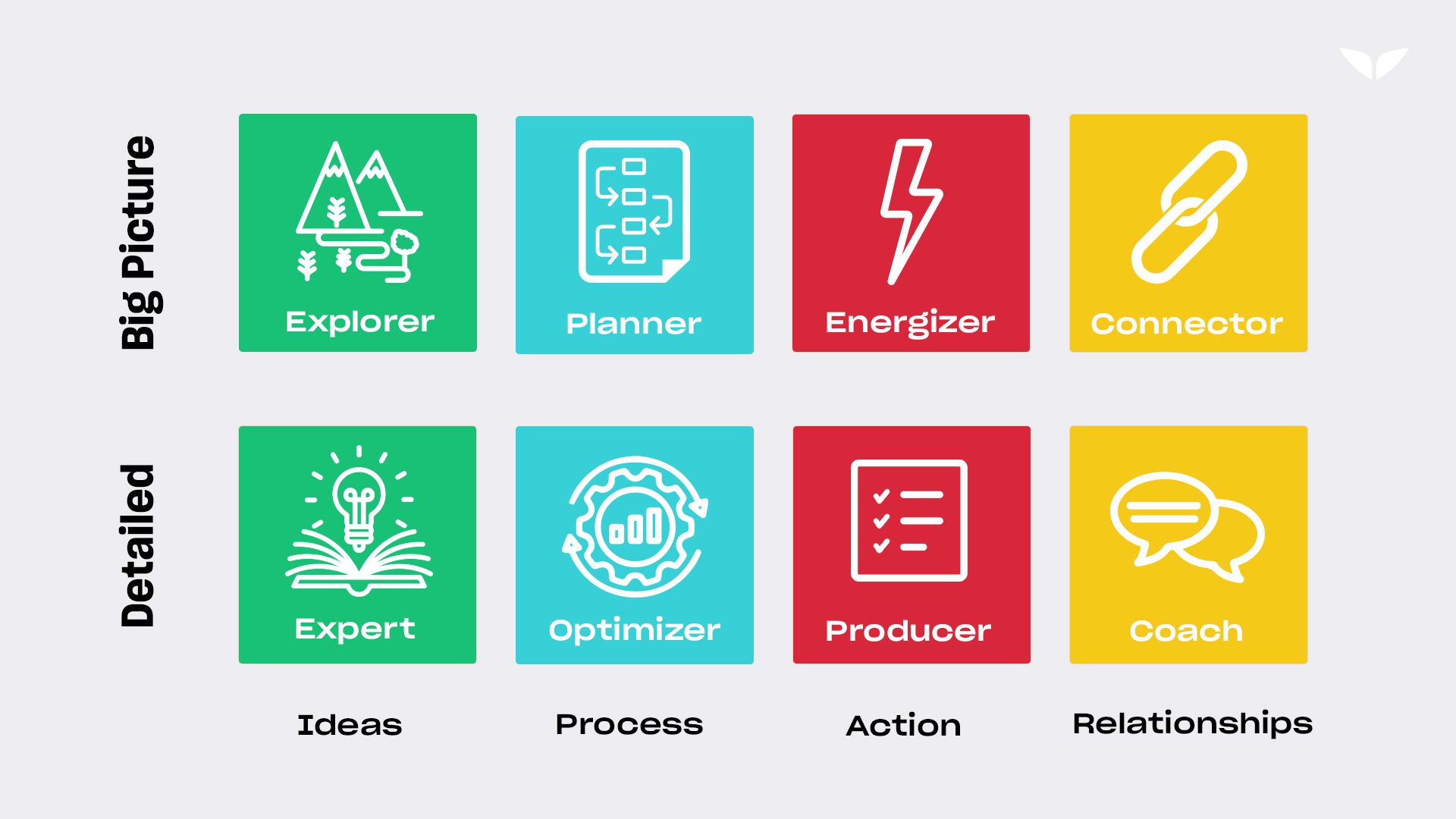Here’s a fun fact: Superman possesses genius-level intelligence and an eidetic memory (also known as photographic memory). This means he’s able to speed read, absorb large amounts of information quickly, and process all this information in minute detail.
Now, there can only be one Superman. But that doesn’t stop us from possessing some degree of a superbrain.
Humans all have default types of thinking—seven common ones, in fact.
But why is this even a thing? It holds importance because when you’re able to identify the type of thinker you are, you can hone in on your thinking skills and unleash your superintelligence.
So dive in to discover the different types of thinking, how to identify yours, and how to improve it.
Types of thinking
There are seven most common types of thinking:
- Creative thinking
- Analytical thinking
- Critical thinking
- Concrete thinking
- Abstract thinking
- Divergent thinking
- Convergent thinking
The way one approaches problems and solutions relies more on how the brain manages and processes information than the facts presented. The thinking type they’ve adopted to work for them really dictates the quality of their outcomes, outputs, and future.
For example, like Superman, Sheldon Cooper from The Big Bang Theory has one of the highest IQs in pop culture and an eidetic memory. But when given the same problem, both of them will most likely approach it differently.
The mind responds to its programming just like a machine. But the difference between you and a machine is that you have the consciousness to choose what source code you want to input.
— Jim Kwik, trainer of Mindvalley’s Superbrain program
So get in your best “The Thinker” pose—let’s deep-dive into the seven thinking types.
1. Creative thinking
Creative thinking is synonymous with “thinking outside the box.” It’s the ability to push past established thoughts, theories, rules, and procedures. In turn, it enables a person to conceive new and innovative ideas by looking at them from a different perspective.
One great example of a creative thinker is Miki Agrawal, trainer for Mindvalley’s Zero to $100 Million program. She found herself facing very common issues—stomach problems, period problems, and pooping problems. And the creative solutions this social entrepreneur came up with led her to create Wild, Thinx, and Tushy.
2. Analytical thinking
Those who think analytically have a structured and methodical way of approaching tasks. They are left-brain dominant individuals with the ability to take something that’s whole and separate it into basic parts to be examined. This makes them great at problem-solving.
One such thinker is Mindvalley’s founder, Vishen. Given his position, having analytical skills comes in handy when it comes to running a global company. This is especially true when it comes to identifying problems (remember the lockdowns?) and solving them.
3. Critical thinking
When it comes to critical thinking, a person exercises careful evaluation or judgment. This allows them to determine the authenticity, accuracy, worth, validity, or value of something. Rather than strictly breaking down information into parts, critical thinkers explore other elements that could impact the conclusions.
Take Mark Cuban, for instance. His role as a judge on Shark Tank requires him to evaluate each sales pitch carefully. He’s also a huge advocate for people with this thinking type, making a prediction in an interview with CNBC that knowing how to think critically is “going to be more valuable” than the trending careers (like programming) of today.
4. Concrete thinking
For a concrete thinker, it’s about practical thinking only, always literal and to the point. They mainly focus on what’s in front of them, but not so much on what’s beyond their viewpoint.
Idioms, metaphors, and analogies often go over their heads. “It’s raining men”—they’ll take it at face value and expect to literally see men falling from the sky.
Infants are a great example of those with concrete thinking. They have yet to develop abstract thinking, so when there’s a toy in front of them, they see it for what it is. Place a blanket over the toy, and the infant will think it has disappeared.
5. Abstract thinking
An abstract thinker is able to relate seemingly random things to each other and make the connections others find difficult to see.
Their forte? Hidden meanings behind things and relate them to other items, events, or experiences. They usually can observe things as theories and/or possibilities. And they’re often curious about how everything relates to the bigger picture.
Case in point: Robert Langdon from Dan Brown’s The Da Vinci Code. The fictional Harvard professor used abstract thinking as well as his knowledge of art history and symbology to decode various complex puzzles in the storyline.
6. Divergent thinking
Divergent thinkers take the path of exploring an infinite number of solutions to find one that is the most effective. So, instead of starting off with a set number of possibilities and converging on an answer, they go as far and wide as necessary and move outwards in search of the solution.
For example, if the faucet breaks, a divergent thinker would try to determine what caused the malfunction and look at all the possible ways to fix it. One option may be to call a plumber, while another may be researching a solution online or finding a video on YouTube.
It takes a little creativity when it comes to this type of thinker. So people like Leonardo Da Vinci use this type of intelligence to stimulate his imagination and create lots of ideas.
7. Convergent thinking
With convergent thinking, a person will focus on finding one, well-defined outcome. They’ll target these possibilities, or converge them inward, to come up with a solution to a problem.
Now, let’s go back to that broken faucet as an example. A convergent thinker will call the plumber right away to fix it. (Or in Sheldon Cooper’s case, fix it himself.)
How to identify your thinking type
Knowing the way you think allows you to understand:
- What motivates you to move and take action.
- Why do you find certain things challenging or boring, and what you can do to enhance areas of your life so you can reach your goals.
- What’s the most efficient way for you to manage people.
- How to develop a better team dynamic with your peers.
- How to become smarter about your personal productivity and growth mindset.
As Jim says, “We need to understand how our minds work so we can work our minds better”. So how would you describe your way of thinking? Logical? Creative? Rational? Or do you think in abstract terms?
If you’re unsure, a “thinking types framework” is one of the best ways to help you map it out.
Thinking types framework
This approach was developed by Mark Bonchek and Elisa Steele. According to them, people tend to have a typical area of focus on ideas, processes, actions, or relationships, with an orientation of looking towards the big picture or the details.

Here’s the two-step breakdown explanation of how to read the thinking type framework.
Step 1: The focus
Think about where you typically focus most of your thinking on. It’s similar to when you consider watching a movie—do you tend to go for action, romance, drama, or mystery?
One way to really hone in is to ask yourself what the first thing you think of is when you wake up in the morning. Do you think about…
- Problems you need to solve?
- Plans you need to make?
- Actions you have to take?
- People you need to see or manage?
These answers will help you identify which of the four key areas you pay the most attention to—ideas, processes, actions, or relationships. It isn’t about picking one over the other, but more of where your “default” focus naturally lands.
Step 2: The orientation
Now, notice whether your orientation of focus swings toward the micro (the details) or the macro (the big picture).
A good way to identify this orientation is by thinking about what tends to bother you in meetings. So ask yourself if you’re more likely to be demotivated when things are too detailed or when things are too general and not specific enough.
Micro (the details):
- Expert thinking is about achieving objectivity and insight
- Optimizer thinking is about improving productivity and efficiency
- Producer thinking is about achieving completion and momentum
- Coach thinking is about cultivating people and potential
Macro (the big picture):
- Explorer thinking is about generating creative ideas
- Planner thinking is about designing effective systems
- Energizer thinking is about mobilizing people into action
- Connector thinking is about building and strengthening relationships
With this two-step framework, your thinking type becomes a super useful tool—a social currency, if you will—one that you can use to your advantage to move towards your higher self.
How to improve your thinking skills
Regardless of which thinking type you resonate with, there are some great brain-hacking techniques out there to improve your thinking skills.
Being a brain expert, one of Jim Kwik’s recommendations is the F.A.S.T. method.
- Forget the things on a subject that you’ve previously learned, keep an open mind, and allow yourself to re-learn something all over again. You may just learn something new.
Jim says, “Often, a lot of people don’t learn faster because they feel like their cup is full and they feel like they know it already. So always remember to start with a beginner’s mind.”
- Active. Learning is a process, not a spectator sport. “One of the challenges is our schools trained us to be very passive,” explains Jim. “But your brain doesn’t learn based on consumption. It learns through creation.”
So be active. Participate and engage. Scribble down notes or ask questions.
- State. This is the current mood of your mind and your body. Jim highlights that the key to a better, long-term memory is “information combined with emotion.” For example, we tend to associate certain songs with certain memories.
“All learning is state-dependent,” he adds. “If you want to learn more, control your state.”
So when you take responsibility for something, like how you feel, you have the power to make your state better. And that’s important, don’t you think?
- Teach. If you want to learn anything faster, learn it the way you would teach it to someone else. That’s because, in order to pass on any knowledge, you’ll have to be well-versed in that subject.
“When you learn it to teach it, then you’re going to pay attention differently,” says Jim. “You’re going to remember it differently because here’s the thing: when you teach something, you get to learn it twice.”
With this method, you’ll be able to focus on any topic you put your mind to, improve your learning style, and unleash the greatness of your superbrain.
Watch Jim Kwik explain his famous F.A.S.T. method in the below video:
Awaken your superbrain
“With great power comes great responsibility.” But the opposite is also true: “With great responsibility comes great power.”
So step into your power by identifying your type of thinking and working to level up your skills. With incredible people out there, like Jim, you’ll always find guidance to make great changes and have a great impact on yourself and those around you.
Sign up for a free webinar with Jim Kwik and learn ten transformational hacks to learn fast and remember more.
Welcome in.









